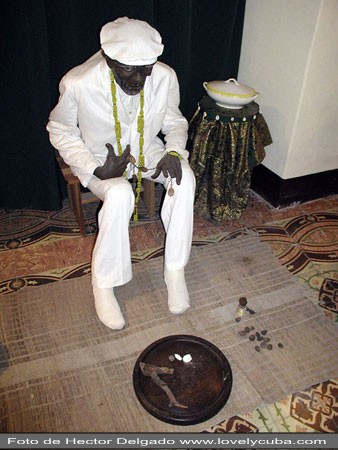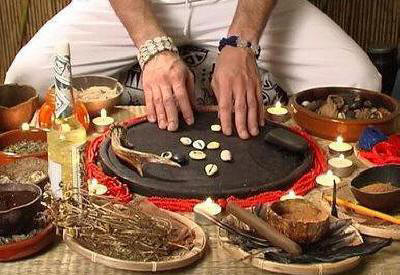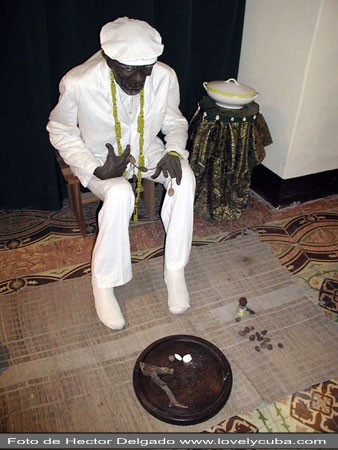A BRIEF HISTORY OF THE BABALAWOS (BABALAOS) IN CUBA.
Babalawo or Babalao, or Babalao Awo is the Yoruba title denoting the priests of Orunmila or Orula. The Orisha of wisdom operating through the Ifa divination system. Orunmila is aware of past, present and future.
The Babalawo as a priest of Ifa, can predict the future and how to handle it through its communication with Orunmila. This is done through consulting Ifa divination chain Opele call or calls ikin sacred seeds on the board of Ifa divination.
Religion Santeria or Lukumí, the Babalawo or father of secrets or Awo, is recognized as a clergyman and acts as such in the community. Awo is a spiritual consultant for customers and those who must be assisted to meet his mentor and Orisha begin in the spiritual tradition of the Orishas.
ENTRY INTO CUBA.
The first babalawo that existed in Cuba was Addeshina (Obbara meyi), this was born in West Africa in the early 1800s, other Yorubas bought their freedom as they recognized their king range, Addeshina means “Crown open-path”. It is said that Addeshina managed to swallow Ikines before he was captured and defecated on the boat.
A few years after he arrived another babalawo known as non Carlos Addebí (Ojuani mouth) who won his freedom in Camaguey thanks to the bet you love your friends guessed his master and they were amazed. He did it with the first okpele that existed in Cuba with a rope made of hibiscus and dried orange peels.
Addebi Addeshina and then found in Havana in Guanabacoa. Ifa Addeshina made him only two people, one went to the United States and not its name is known and the other was Bernardo Rojas (Irete Tendi). Bernardo Addeshina nursed until his death, and with everything he learned Ifa.
Bernardo Rojas of the largest branch of Cuba Babalawos arises. Bernardo was the most devoted godchildren. The other great pillar was Taita branch Gaitán (Oggunda fun), born in Matanzas, his godfather was another babalawo brought as slave named Lugery (Oyekun meyi) who returned to Nigeria and there died, but before he sent Taita Gaitan with his brother consecration was in Matanzas, Cardenas called No, he never consecrated anyone but taught him everything Taita Gaitan. And another famous branch Villalonga was to Asuncion.
The first native who became Cuba Ifa called Cornelio Vidal and the other branch arises.
All these branches at the end crossed with each other. Our elders in CNorberto Noriega ifa are Addeshina (Obbara meyi) Addebí (Ojuani mouth), Barnabas Menocal, Baba Ejiogbe Babel (Ifa Lola), Taita Gaitán (Oggunda fun), Bernardo Rojas (Irete Tendi), Cornelio Vidal, Asuncion Villalonga Guillermo Castro, Alfredo Rivero, Joaquin Salazar (OSA Forbeyo), Ramon Febles (Ogbe tua), Panchito Febles (Otura Niko), Miguel Febles, Sevilla Baró (Oshe Yekun), the Chinese Poey (Oshe Paure), Felix the Black ( Osa Rete) and Andres Bombalier (Oggunda BIODE).
Santeria / Yorubahistory / InternetPhotos / TheCubanHistory.coom
The Cuban History, Hollywood.
Arnoldo Varona, Editor.
BREVE HISTORIA DE LOS BABALAOS EN CUBA.
Babalawo o Babalao, Awo o Babalao es el título Yoruba que denota a los Sacerdotes de Orunmila u Orula. El Orisha de la sabiduría que opera a través del sistema adivinatorio de Ifá. Orunmila es conocedor del pasado, el presente y el futuro.
El Babalawo como sacerdote de Ifá, puede predecir el futuro y como manejarlo a través de su comunicación con Orunmila. Esto se hace consultando a Ifá a través de la cadena de adivinación llamada Opele, o semillas sagradas llamadas ikin sobre el tablero de adivinación de Ifá.
En la Santería o Religión Lukumí, el Babalawo o padre de los secretos o Awo, es reconocido como clérigo y actúa como tal en la comunidad. Un Awo es el consultor espiritual para los clientes y aquellos que deben ser asistidos para conocer a su Orisha tutelar e iniciarse en la tradición espiritual de los Orishas.
ENTRADA EN CUBA.
El primer babalawo que hubo en Cuba fue Addeshina (Obbara Meyi), este nació en Africa Occidental a principios de los 1800, otros Yorubas compraron su libertad ya que reconocieron su rango de rey, Addeshina significa “Corona abre-camino”. Se dice que Addeshina logró tragarse los ikines antes que lo capturaran y los defecó en el barco.
Unos años despues de el llego otro babalawo conocido como Ño Carlos Addebí (Ojuani Bocá) que logró su libertad en camaguey gracias a que la apostó a su amo a que le adivinaba a los amigos de su amo y estos quedaron sorprendidos. Lo hizo con el primero okpele que existió en Cuba hecho con una soga de majagua y con cascaras de naranja secas.
Addeshina y Addebi se encontraron luego en la Habana, en Guanabacoa. Addeshina le hizo ifá a solo dos personas, una se fue para estados unidos y no se conoce su nombre y el otro fue Bernardo Rojas (Irete Tendi). Bernardo cuidó a Addeshina hasta su muerte, y junto a el aprendio todo lo de Ifá.
De Bernardo Rojas surge la rama mas grande de babalawos de Cuba. Bernardo fue el que mas ahijados consagró. El otro gran pilar fue la rama de Taita Gaitán (Oggunda fun), nacido en matanzas, su padrino fue otro babalawo traido como esclavo llamado Lugery (Oyekun Meyi) que regresó a Nigeria y allá murió, pero antes de irse mandó a Taita Gaitán con su hermano de consagracion que estaba en Matanzas, llamado Ño Cárdenas, que nunca consagró a nadie pero le enseñó todo a Taita Gaitán. Y otra rama famosa fue la de Asunción Villalonga.
El primero criollo que se hizo Ifá en Cuba se llamó Cornelio Vidal y de el surge otra rama.
Todas estas ramas al final se cruzaron una con otras. Nuestros mayores en ifa en CNorberto Noriega son Addeshina (Obbara meyi), Addebí (Ojuani Bocá), Bernabé Menocal, Babel Babá Ejiogbe (Ifá Lolá), Taita Gaitán (Oggunda fun), Bernardo Rojas (Irete Tendi), Cornelio Vidal, Asuncion Villalonga, Guillermo Castro, Alfredo Rivero, Joaquin Salazar (Osá Forbeyo), Ramon Febles (Ogbe tua), Panchito Febles (Otura Niko), Miguel Febles, Sevilla Baró (Oshe Yekun), el Chino Poey (Oshe Paure), Felix el Negro (Osa Rete) y Andres Bombalier (Oggunda Biode).
Santeria/Yorubahistory/InternetPhotos/TheCubanHistory.coom
The Cuban History, Hollywood.
Arnoldo Varona, Editor.



 SANTERIA: A BRIEF HISTORY of The Babalawos (BABALAOS) in Cuba. + SANTERIA: BREVE HISTORIA de los BABALAOS en Cuba.
SANTERIA: A BRIEF HISTORY of The Babalawos (BABALAOS) in Cuba. + SANTERIA: BREVE HISTORIA de los BABALAOS en Cuba.



